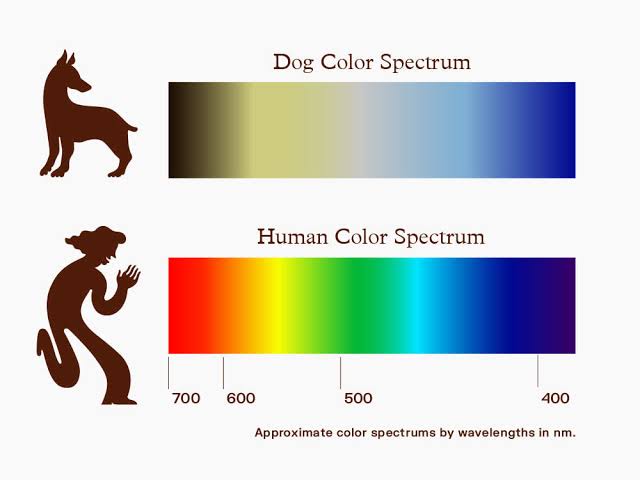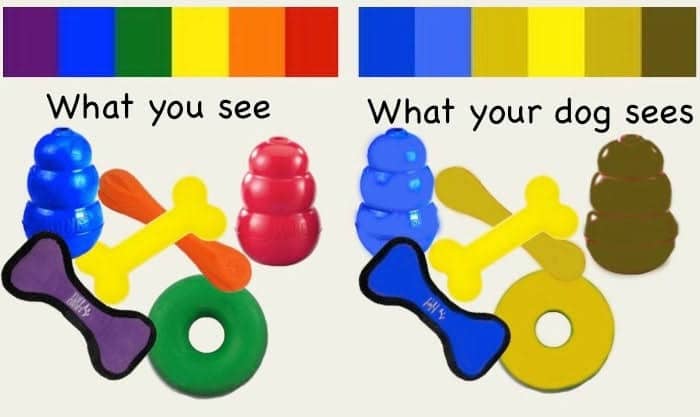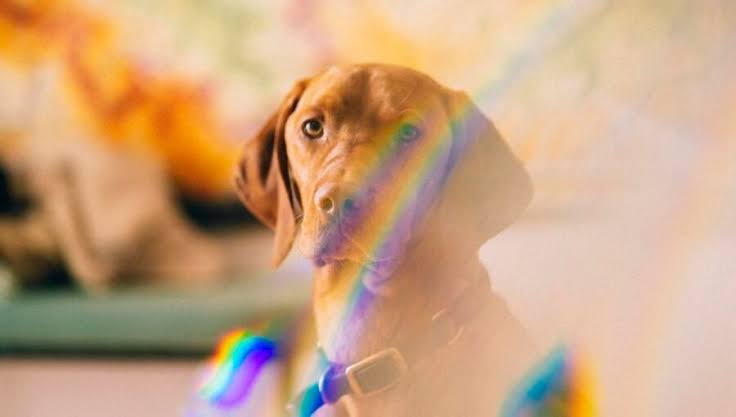Ever wondered howbyour dog views the world? Dogs perceive the world differently from humans, especially when it comes to color. While we see a vibrant spectrum of colors, dogs have a more limited color vision. In this article, we’ll explore what colors dogs can see, how their vision differs from ours, and what this means for their daily lives and interactions with their environment.
Understanding how dogs see color is not only fascinating but also important for their well-being. It helps us design environments that are visually stimulating for them and choose toys and accessories that they can see and appreciate. By gaining insight into their color vision, we can enhance our relationships with our canine companions and provide them with a more enriching and fulfilling life.
Join us on a journey into the world of canine color vision, where we’ll uncover the mysteries of what colors dogs can see and how they perceive the colorful world around them.
Recommended article: 10 Creative DIY Dog Run Ideas: Transforming Your Outdoor Space
Myths About Dog’s Sight: Debunking Common Misconceptions
There are many myths and misconceptions surrounding the way dogs see the world. Let’s take a closer look at some of these myths and separate fact from fiction when it comes to understanding canine vision.
1. Myth: Dogs see the world in black and white.
- Fact: While it’s true that dogs’ color vision is different from humans’, they are not limited to seeing in black and white. Dogs can see a range of colors, although their color perception is more limited compared to humans. They primarily see blues and yellows, with difficulty distinguishing between reds and greens.
2. Myth: Dogs have poor vision.
- Fact: While dogs may not have the same level of visual acuity as humans, they have other visual abilities that make up for it. Dogs have excellent motion detection and low-light vision, which are important adaptations for hunting and navigating their environment.
3. Myth: Dogs can’t see in the dark.
- Fact: Dogs have better night vision than humans due to their larger pupils and a high number of rod cells in their retinas. This allows them to see in low-light conditions much better than we can.
4. Myth: Dogs can’t see TV or computer screens.
- Fact: Dogs can see TV and computer screens, but their perception of images may be different from ours. They may not be as interested in two-dimensional images as they are in real-life movement and scents.
5. Myth: Dogs are colorblind.
- Fact: While dogs do not see colors the same way humans do, they are not completely colorblind. They can see some colors, but their range is more limited compared to humans. Their color vision is adapted for their specific needs as predators and scavengers.
6. Myth: Dogs see the world in shades of gray.
- Fact: Dogs see the world in shades of blue and yellow, with some ability to distinguish between other colors. Their color vision is not as vivid as ours, but it is more than just shades of gray.
7. Myth: Dogs can’t see objects that don’t move.
- Fact: While dogs are more attuned to moving objects, they can see stationary objects as well. Their ability to detect motion is a survival adaptation, but they are capable of seeing and recognizing stationary objects.
While dogs’ vision differs from humans’ in some ways, they have their own unique visual abilities that are well-suited to their needs as animals. Understanding these differences can help us better understand and care for our canine companions.
Recommended article: Best Automatic Dog Treat Dispenser 2024
How Dogs See Color
Dogs’ eyes have fewer cones than human eyes, which are the cells responsible for color vision. While humans have three types of cones (red, green, and blue), dogs have two main types (blue and yellow). This means that dogs’ color vision is limited compared to humans.
The retina, the light-sensitive layer at the back of the eye, also plays a role in color perception. Dogs have more rod cells in their retinas, which are responsible for low-light vision and detecting motion, but fewer cone cells for color vision compared to humans.
Types of Cones in Dogs’ Eyes
Dogs have two types of cones: blue-sensitive cones and yellow-sensitive cones. These cones allow dogs to perceive a range of colors, but they have difficulty distinguishing between reds and greens.
Blue and yellow are the primary colors that dogs can see, while reds and greens appear as shades of gray or brown to them. This means that dogs’ color vision is similar to that of a person with red-green color blindness.
How Dogs’ Color Vision Affects Their Perception
Dogs’ limited color vision affects how they perceive their environment. They rely more on brightness, contrast, and motion than on specific colors.
While dogs may not see the same vibrant colors as humans, they can still distinguish between objects based on their brightness and texture. For example, they can differentiate between a yellow ball on green grass because of the contrast in brightness.
Comparing Dogs’ Color Vision to Humans

To understand how dogs see color, imagine looking at the world through a slightly foggy or sepia-toned filter. Colors may appear muted or less distinct, but shapes and contrasts are still visible.
While dogs’ color vision is limited compared to humans, they have other sensory abilities, such as a keen sense of smell and hearing, that compensate for their visual differences.
Implications for Dog Owners
Understanding dogs’ color vision can help dog owners choose toys and accessories that are more visually stimulating for their pets. Opting for toys in shades of blue or yellow can be more appealing to dogs than those in red or green.
It’s also important to consider dogs’ reliance on other senses, such as smell and hearing, when designing their living spaces and interactions.
Dogs’ color vision is a fascinating aspect of their sensory abilities. While they may not see the world in the same colorful palette as humans, they have unique visual adaptations that allow them to thrive in their environment.
Recommended article: Tips for Grooming Different Types of Dog Coats
Colors Dogs Can See

Dogs’ color vision is dichromatic, meaning they have two types of cones in their eyes that are sensitive to different wavelengths of light. This allows them to perceive a range of colors, albeit with limitations compared to humans.
While humans have three types of cones (red, green, and blue), dogs lack the red cone and have cones that are most sensitive to blue and yellow wavelengths of light. This means dogs see the world in shades of blue, yellow, and gray, with less distinction between reds and greens.
Blues and Yellows: Dog-Friendly Colors
Dogs’ enhanced sensitivity to blues and yellows has practical implications in their daily lives. They can easily distinguish between various shades of blue and yellow, which are prevalent in their natural environment.
Blue hues stand out to dogs, making them more visible against green backgrounds. This ability is advantageous for spotting prey or navigating through vegetation.
Adaptations for Hunting and Survival
Dogs’ color vision is adapted for their ancestral role as hunters and scavengers. Their ability to differentiate between blues and yellows helps them detect subtle changes in their surroundings, such as movement or camouflage patterns.
In the wild, blue and yellow hues are often associated with potential food sources or threats, allowing dogs to make quick decisions based on color cues.
Limitations in Red and Green Perception
Dogs’ limited ability to perceive reds and greens is due to their lack of a red cone. This means they see these colors as variations of gray, making them less distinct and vibrant compared to blues and yellows.
While dogs can still differentiate between some shades of red and green, these colors appear muted and less attention-grabbing to them.
Dogs’ color vision is attuned to their evolutionary needs, with a focus on detecting blues and yellows for hunting and survival. While their color palette differs from ours, dogs navigate their colorful world with ease, relying on their keen senses to interpret the nuances of their environment.
Recommended article: Best Dog Food for Skin Allergies
Impact of Color Vision on Dogs
Let’s explore the fascinating impact of color vision on dogs and how it shapes their behavior and communication.
Role of Color Vision in Object Recognition
Dogs rely on their color vision to distinguish between objects and make sense of their surroundings. While they may not see colors as vividly as humans, they can still use color cues to identify familiar objects and navigate their environment.
For example, a dog may be able to differentiate between a blue ball and a green ball based on their color vision, allowing them to choose the toy they prefer or recognize their favorite playthings.
Color Signals in Dog Communication
Dogs use a variety of visual signals to communicate with humans and other dogs, and color can play a role in these interactions. For example, a dog may use body language and color cues to signal playfulness, submission, or aggression.
Understanding these visual cues can help dog owners interpret their pets’ behavior and respond appropriately. For instance, a dog with a red toy may be signaling excitement or arousal, while a dog with a blue toy may be displaying a more relaxed or contented demeanor.
Influence of Color on Training and Behavior
The use of color in training can be an effective way to communicate with dogs and reinforce desired behaviors. For example, using brightly colored markers or toys to indicate specific actions or commands can help dogs learn and respond to cues more effectively.
Additionally, the color of a dog’s environment can impact their mood and behavior. Bright, stimulating colors may energize a dog, while softer, more muted colors may have a calming effect.
While dogs’ color vision may differ from ours, it still plays a significant role in how they perceive and interact with the world. Understanding their color preferences and how they use color signals in communication can enhance our relationship with these beloved companions.
Recommended article: 30 Valentine’s Day Gift Ideas for Pets
What Colors Can Dogs See in the Dark
Dogs are crepuscular animals, meaning they are most active during twilight hours when there is limited light. Their eyes are equipped with special adaptations that enhance their vision in low-light conditions. Dogs have a higher number of rod cells in their retinas, which are sensitive to low levels of light. This allows them to see better in dim light compared to humans.
Limited Color Perception in the Dark
While dogs’ night vision is superior to humans’ in terms of brightness and movement detection, their ability to perceive colors is limited in low-light environments. In the dark, dogs primarily rely on their rod cells, which are not sensitive to color. As a result, they see the world in shades of gray rather than full color when in the dark.
Enhanced Motion Detection
Dogs excel at detecting movement in the dark due to their high number of rod cells. This allows them to spot prey or potential threats even in low-light conditions. Their ability to detect motion helps them navigate their environment and react quickly to changes in their surroundings.
Utilizing Other Senses
In addition to their vision, dogs rely on their sense of smell and hearing to navigate and communicate in the dark. Their keen sense of smell allows them to identify objects and individuals, while their acute hearing helps them locate sounds and communicate with other animals.
Implications for Nighttime Activities
Understanding dogs’ limited color perception in the dark can impact how we interact with them during nighttime activities. When playing with your dog in low-light conditions, consider using toys that contrast with the environment to enhance visibility, such as light-colored or reflective toys.
While dogs’ night vision is optimized for detecting motion and navigating in low-light conditions, their ability to perceive colors is limited in the dark. This unique nocturnal vision allows them to thrive in twilight hours, relying on their other senses to complement their visual capabilities.
Recommended article: List of Dog Safe Flowers
What Colors Can Dogs Not See
Dogs have difficulty distinguishing between reds and greens due to their limited sensitivity to these colors. Reds may appear as shades of gray or brown to them, while greens may blend in with their surroundings. Colors that are more visible to dogs include blues and yellows, which appear brighter and more distinct to them.
While dogs’ color vision limitations may not significantly impact their daily activities, it can affect their perception of certain objects and environments. For example, dogs may have difficulty distinguishing between red and green toys, but they can easily spot a blue ball on green grass.
What Colors Can Dogs See in Humans
When dogs look at humans, they may perceive a world that is predominantly blue and yellow, with less emphasis on red and green hues. This can affect how they perceive objects and people in their environment.
Recommended article: 15 Fun and Cool Tricks to Teach your Dog
Frequently Asked Questions
1. Can dogs see in color?
Yes, dogs can see in color, but their color vision is different from humans. Dogs primarily see shades of blue and yellow, with difficulty distinguishing between reds and greens.
2. What colors can dogs see best?
Dogs see best in shades of blue and yellow. They have fewer color receptors (cones) in their eyes compared to humans, which limits their ability to see other colors.
3. Do dogs see in black and white?
No, the idea that dogs see in black and white is a misconception. While they see fewer colors than humans, dogs do perceive some colors, particularly blues and yellows.
4. Do dogs see TV in color?
Dogs see TV differently from humans. They can perceive motion and some changes in brightness, but their ability to see the colors on TV screens is limited compared to humans.
5. How does a dog’s color vision affect their behavior?
A dog’s color vision affects their behavior in various ways. For example, their ability to perceive blues and yellows may influence their preference for certain toys or objects based on color cues. Understanding their color vision can help in training and creating a visually stimulating environment for them.
Recommended article: How to Find the Best Dog Daycare Near Me
Conclusion
In conclusion, understanding what colors dogs can see offers us a glimpse into their unique visual world. While dogs see fewer colors and in a more limited spectrum than humans, their ability to interpret motion, contrast, and other visual cues plays a crucial role in their interactions with the world around them.
By considering dogs’ color vision in training, toy selection, and environmental design, we can enhance their well-being and strengthen our bond with them. Remember, dogs rely on a combination of senses, including smell, hearing, and vision, to navigate their lives, and understanding their perspective can enrich our relationship with these beloved companions.
For more articles on pet care, behavior, breeding, and other topics related to our furry friends, check out our website. Stay informed and connected to the world of responsible pet ownership and companionship!

